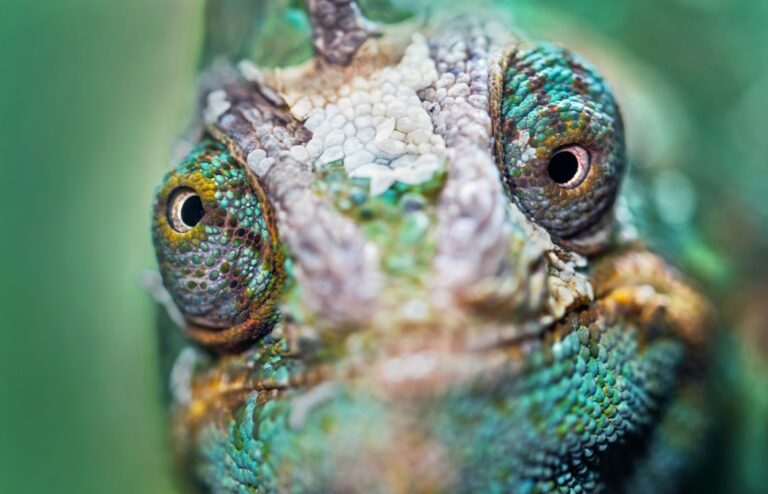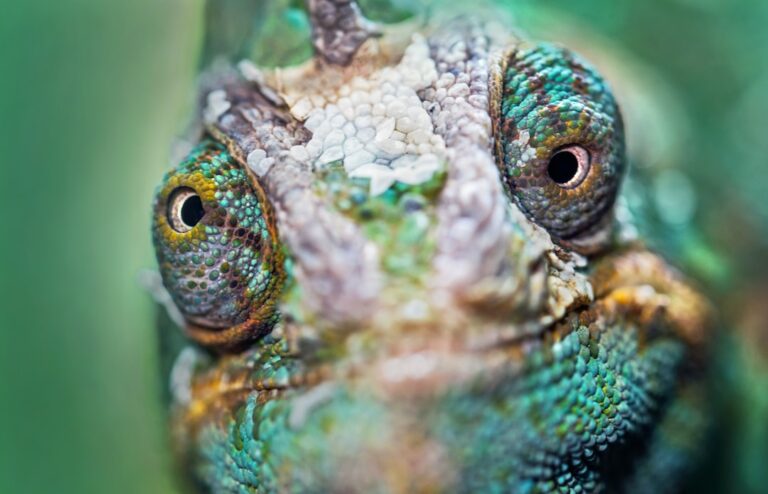Are Chameleons Sensitive To Sound?
Chameleons are fascinating creatures known for their ability to change color and their unique eyes. They belong to the family Chamaeleonidae and are native to Africa, Madagascar, and parts of southern Europe and Asia. Chameleons are known for their distinctive physical characteristics, such as their long, curled tails, independently moving eyes, and zygodactyl feet (two toes pointing forward and two pointing backward).
One of the most remarkable abilities of chameleons is their ability to change color. This is not just for camouflage, but also for communication and thermoregulation. Chameleons have specialized cells in their skin called chromatophores, which contain pigments that can expand or contract to change the color of the skin. This allows them to blend into their surroundings or display vibrant colors to attract mates or intimidate rivals.
In addition to their color-changing abilities, chameleons also have unique eyes. Their eyes can move independently of each other, allowing them to have a 360-degree field of vision. This gives them excellent depth perception and the ability to focus on two different objects simultaneously. Chameleons also have a specialized structure called a “cone” in their eyes that allows them to see ultraviolet light, which is invisible to humans.
Table of Contents
Understanding Sound Sensitivity in Animals
Sound is an important sensory modality for many animals. It plays a crucial role in communication, navigation, and detecting potential threats or prey. Animals perceive sound through specialized structures in their ears, which convert sound waves into electrical signals that can be processed by the brain.
Different animals have different levels of sound sensitivity depending on their evolutionary history and ecological niche. For example, animals that rely on sound for communication, such as birds and mammals, tend to have more developed auditory systems compared to animals that primarily rely on other senses, such as vision or smell.
Sound sensitivity in animals is not limited to just hearing. Some animals, like elephants and whales, can produce and perceive low-frequency sounds that are beyond the range of human hearing. These infrasounds can travel long distances and are used for long-distance communication and navigation.
The Anatomy of Chameleon Ears and Hearing Mechanisms
Chameleons have a unique ear anatomy compared to other reptiles. Their ears are located behind their eyes and are covered by a thin layer of skin. They have a small external ear opening called the tympanic membrane, which is connected to the middle ear by a short tube called the Eustachian tube.
Inside the middle ear, chameleons have three small bones called ossicles that transmit sound vibrations from the tympanic membrane to the inner ear. The inner ear contains the cochlea, which is responsible for converting sound vibrations into electrical signals that can be processed by the brain.
Chameleons have been found to have a relatively low frequency range of hearing compared to other reptiles. They are most sensitive to frequencies between 200 and 600 Hz, which is within the range of human speech. This suggests that chameleons may be able to perceive and respond to certain types of sounds in their environment.
Do Chameleons Respond to Sound? A Scientific Study
A scientific study conducted by researchers at the University of South Africa sought to investigate whether chameleons respond to sound stimuli. The researchers exposed captive chameleons to different types of sounds, including natural sounds like bird calls and artificial sounds like tones and white noise.
The study found that chameleons did indeed respond to sound stimuli. They exhibited changes in behavior, such as increased movement or changes in body coloration, when exposed to certain sounds. The researchers concluded that chameleons are capable of perceiving and responding to sound, although the exact mechanisms and functions of their auditory system are still not fully understood.
The Role of Sound in Chameleon Communication and Social Behavior
While the exact functions of sound in chameleon communication are still being studied, it is believed that sound plays an important role in their social interactions and territorial behavior. Chameleons have been observed making vocalizations, such as hisses, clicks, and trills, during aggressive encounters or courtship displays.
These vocalizations are thought to serve as a means of communication between individuals. For example, a male chameleon may use vocalizations to establish dominance or attract a mate, while a female chameleon may use vocalizations to signal her receptiveness to mating.
In addition to vocalizations, chameleons also use body language and color changes to communicate with each other. They can display vibrant colors to signal aggression or submission, or they can change their body posture to convey different messages.
How Loud Noises Affect Chameleons in Captivity
Loud noises can have a negative impact on chameleons kept in captivity. Chameleons are sensitive to sudden loud noises, which can startle them and cause stress. Prolonged exposure to loud noises can also lead to chronic stress, which can have detrimental effects on their health and well-being.
In addition to stress, loud noises can also disrupt the natural behaviors of chameleons. For example, if a chameleon is constantly exposed to loud noises, it may become reluctant to engage in normal activities like feeding or basking. This can lead to decreased appetite and overall decline in health.
To minimize the negative effects of loud noises on captive chameleons, it is important to provide them with a quiet and peaceful environment. This can be achieved by placing their enclosure in a quiet area of the house away from sources of noise, such as loud appliances or busy roads. It is also important to avoid sudden loud noises, such as slamming doors or loud music, in the vicinity of the chameleon’s enclosure.
The Impact of Environmental Noise Pollution on Chameleon Populations
Noise pollution from human activities can have a significant impact on chameleon populations in the wild. Chameleons rely on sound for communication and detecting potential threats or prey, so excessive noise can disrupt their ability to navigate their environment and find food or mates.
One of the main sources of noise pollution in chameleon habitats is human development, such as construction and urbanization. The noise generated by these activities can mask important sounds in the environment, making it difficult for chameleons to communicate and locate resources.
Noise pollution can also have indirect effects on chameleon populations by altering their behavior and physiology. For example, chronic exposure to loud noises can increase stress levels in chameleons, which can suppress their immune system and make them more susceptible to diseases.
Can Chameleons Learn to Recognize Specific Sounds?
Chameleons have been found to have learning abilities, so it is possible that they can learn to recognize specific sounds. However, more research is needed to determine the extent of their learning abilities and whether they can form associations between specific sounds and certain events or stimuli.
In a study conducted by researchers at the University of California, captive chameleons were trained to associate a specific sound with a reward. The chameleons were able to learn this association and respond accordingly when they heard the sound.
This suggests that chameleons have the cognitive ability to learn and remember specific sounds, although the exact mechanisms and limitations of their learning abilities are still not fully understood.
The Evolutionary Significance of Sound Sensitivity in Chameleons
The evolution of sound sensitivity in chameleons is believed to be driven by their ecological niche and social behavior. Chameleons are primarily arboreal creatures, meaning they live in trees and rely on visual and auditory cues to navigate their environment and communicate with each other.
Sound sensitivity allows chameleons to detect potential threats or prey from a distance, even when they are hidden from view. It also allows them to communicate with other chameleons over long distances, which is important for establishing territories and finding mates.
However, sound sensitivity also has its disadvantages. Chameleons are vulnerable to loud noises, which can startle them and disrupt their normal behaviors. This is why chameleons are often found in quiet and peaceful environments, away from sources of noise.
Tips for Creating a Quiet and Comfortable Environment for Your Pet Chameleon
If you have a pet chameleon, it is important to create a quiet and comfortable environment for them to thrive. Here are some tips to achieve this:
1. Choose a quiet location: Place your chameleon’s enclosure in a quiet area of your home, away from sources of noise like loud appliances or busy roads.
2. Use soundproofing materials: Consider using soundproofing materials, such as foam panels or acoustic curtains, to reduce noise levels in the chameleon’s enclosure.
3. Minimize sudden loud noises: Avoid slamming doors or playing loud music near the chameleon’s enclosure, as these sudden loud noises can startle and stress them.
4. Provide hiding spots: Create hiding spots in the enclosure where the chameleon can retreat to if they feel stressed or threatened. This can be done by adding plants or branches that provide cover.
5. Maintain a peaceful atmosphere: Keep the chameleon’s environment calm and peaceful by avoiding unnecessary disturbances or sudden changes in their surroundings.
Conclusion:
In conclusion, chameleons have unique abilities and characteristics that make them fascinating creatures. Their ability to change color and their unique eyes are just some of the features that set them apart from other animals.
Sound sensitivity plays an important role in chameleon communication and behavior. Chameleons have a unique ear anatomy and are capable of perceiving and responding to sound stimuli. They use sound, along with body language and color changes, to communicate with each other and establish territories.
Loud noises can have a negative impact on chameleons in captivity and in the wild. It is important to provide them with a quiet and peaceful environment to minimize stress and promote their well-being.
Overall, understanding the importance of sound sensitivity in chameleons can help us create better environments for their survival and well-being. By minimizing noise pollution and providing a peaceful atmosphere, we can ensure that these fascinating creatures thrive in their natural habitats and in captivity.
If you’re interested in learning more about reptiles, you might also enjoy reading the article “Can Bearded Dragons Burp?” on Reptile Friend. It explores the fascinating digestive system of bearded dragons and whether or not they have the ability to burp. Check it out here.







